You are here:
- Home
- Where are we?
- Uman
- Area Profile
Area Profile - Uman
-
What is the history of the Jewish community?
- The emergence of the Jewish community
- The Jewish community before the Revolution
- Early Soviet period
- The Holocaust years
- Post-war situation
- The revival of the Jewish community
- What should I see there?
- Where can I feel the Jewish spirit?
- Are there any historically significant people?
- What is the lifestyle of the modern local community like?
- Where can I eat delicious kosher food?
- The things worth spending money on
- What should I bring back home with me?
- What is the best way for me to get there?
- Where should I stay?
- What should I read and see?
- Whom can I contact with any questions?
- What should I pack for my trip?
- Useful vocabulary
The emergence of the Jewish community
The Jewish community before the Revolution
Early Soviet period
The Holocaust years
It was 1616 when Uman had been mentioned for the first time. In the first half of the XVIII century, invited by the castle owner Francisco Seleziy Pototsky, versatile groups of merchants appeared in the city and Jews were among them. Later on Jewish handymen and traders came. However, because of frequent invasions of Haydamaks, Jews of Uman could not call their life a tranquil one.
In 1768 during one of rebellions of Christian Ukrainian population against economical, religious and national oppression, which was called Koliyivschuna, thousands of Jews and Poles who found their shelters behind the walls of Uman's forts, died in Uman's battles. The total number of victims, according to different accounts was between 12000 and 20000.
To commemorate this event, Jewish residents of Uman before the start of XX century used to fast on 5th of Tammuz, and they were reading a special memorial prayer that day in their synagogues.
The first document about existence of the Jewish block (kvartal), which consisted of Verxney Evreiskoy, Nizhney Evreiskoy and Gr’aznoy streets in Uman falls under 1861.
Starting at the end of the XVIII century and till the end of XIX century the number of Jewish population of Uman was rapidly growing. This happened after the second division of Poland in 1793, when part of it fell under Russian Empire. In the year 1801 - 1895 Jews lived there, in 1847 – 4333, and in 1897 – 17,945. On Verxn'aya street of the old City, near City's Main Synagogue, a new synagogue of Bratslav Hasidim, small houses for praying, mikvas, classrooms (heders) and stores of Jewish merchants were built. There was a free dining room for poor people and orphans as well as a heder.
At the beginning of the XIX century Uman became one of the center point of Hasidic movement. Rabbi Nahman from Bratslav lived in Uman his last years. He was one of the spiritual Hasidic leaders in Ukraine and the founder of Bratslav Hasidic movement.
From 1820's Uman became one of the first centers of Haskala in Ukraine.
By the year 1900 there were 3 synagogues, 13 Jewish praying houses (by trades: shoemakers had their own, tailors had their own, etc.) 4 private Jewish Colleges and Talmud-Torah centers.
By the year 1914 – there was 28267 Jews in Uman (56.2% of the city population).
The first half of 1919 in Uman same as everywhere – a time of pogroms. 170 people became victims of only one of them. In 1920's heder at synagogue was abolished, and in 1937 the local authorities confiscated the synagogue itself. The whole décor and attributes of a synagogue was destroyed. With the abolition of the pale of settlement, Jewish population started migrating to big cities, so that in 1939 it went down to 13,233 (29.8% of all population).
In August 1st of 1941 Uman was occupied by Nazis. Concentration camp "Umanskaya Yama" ("Uman's Pit") was created there. At the outskirts of the city in Suhoy Yar, invaders killed 12,000 to 17,000 Jews according to different accounts. There is a commemorative plug today at the place where people were killed.
City was liberated as a result of a Umansko-Botoshanskoy operation on March 10, 1944.
Last synagogue was shut-down by authorities at the end of 1950's . Both synagogues survived in Uman, as a part of Jewish settlement territory in old Uman, turned out to be on the ground of "Megometr" plant. This plant broke the ground on May 5th, 1957. More then half of a century these buildings had not been used according to their original needs. Factory industrial-production departments are located there now.
New residential houses were built on the territory of the old Jewish Cemetery. Pilgrimage on Rabbi Nahman grave was forbidden, but never the less Hasidic people continued to visit this place.
In 1959 about 2,200 Jews (5% of all population) lived in the city, and by the end of 1960’s approximately 1,000 people lived there.
After Ukraine gained its independence in 1991, according with a law issued by Leonid Kravchuk, the grave of Rabbi Nahman got an official status of historical-cultural center of Bratslav hasidim. Soon after Bratslav hasidim purchased the lot where this grave is located. The number of Pilgrims increased dramatically. They built a synagogue in Uman and built beit-midrash. Recently, by the grave of Rabbi Nahman a construction of one of the largest synagogues in Europe designed for 6000 worshipers.
Local community, according to different accounts, has 60 - 200 people.
One of the most appreciated hasidic sacred places, the place of annual mass pilgrimage – the grave of the founder of Bratslav Hasidim Rabbi Nahman from Bratslav. He moved to Uman in 1810 and willed to bury him just at this place to commemorate Jewish people who were killed here during Uman’s massacre. Tradition to visit the grave of the righteous prior to Jewish New Year has a history of two hundred years. This tradition was introduced by Rabbi Nathan – a student of Rabbi Nahman. The survived synagogues are: synagogue erected in XVIII – XIX centuries at the old Jewish block, and hasidic synagogue – at the terrace of the high right bank of the river Kamenka.
The famous Sofyievsky Park is a pearl of garden-and-park design. It was built by Count Stanislav Pototsky for his wife Sofia. Among the places of interest mentioned in tour guides, there is also a monument to the leaders of people farmland workers rebellion of the XVII century – Koliyivschunu, when many Jewish and Polish people were massacred in Uman – to Ivan Gonta and Ivan Zaliznyak. About 3 kilometers from the city there is a Suhoy Yar – place of mass killing of Jews in 1941. Also we would recommend you to visit a unique museum of Tripoli culture and art.
In old Uman areas one can get an impression that this city had never stopped being a Jewish shtettle. Jewish spirit is everywhere: in building architecture, in tiny streets that are hiding at the very heart of the city behind the "Uman" hotel, and faded traces of mezuza by the doors of abandoned houses. In the area close to Rabbi Nahman’s grave one can hardly hear Russian speech. There is hasid Daniel’s souvenirs store, where one can always hear trans-style music, and even little boys who run around the store are having side locks and speak Hebrew.
Rabbi Nahman from Bratslav (AKA Rabbi Nahman; 1772 – 1810) founder of Bratslav (Breslov) hasidism.
Rabbi Nathan Shternharts (1780 – 1845) leader of Bratslav hasidism after the death of Rabbi Nahman.
Haim Gurwich (1750-1822) – maskil and wood trader, who published in 1817 a free lance book in Yiddish "Discovery of America" by Joachim Kampe.
Hirsh-Ber (German Bernard) Gurvitch (1775-1860) a founder of the first Comprehensive Jewish School in Russian Empire. School was based on Mozes Mendelson ideas.
Gershl (Grigoriy) Polanker (1911-1997) – Jewish righter in Yiddish.
Moisei Haschevatuy (1897-1943) – Jewish righter, poet and a play-righter in Yiddish.
Mordehai Spector (1858 – 1925) – Jewish righter, journalist and editor. He wrote in Russian and Yidish.
Raisa Troyanker (1908-1945) – Ukrainian and Russian poet and journalist of Jewish origin.
Esra Finninberg (1899 – 1946) – Jewish poet, author of lyrics in Hebrew, Yiddish and Russian.
Valentiy-Alexander Kalinovsky (? – 1620) General Podolskyi and commander Bratslavsky and Vinnitsky. He founded a small town Uman (Hyman).
Francisck Salezy Pototsky (circa 1700-1772) – Polish state and military leader, one of the richest people of his time, the owner of enormous wealth at Naddneprianskoy Ukraine. He was called the "young king of Russia", he owned the castle in Uman in the first half of XVIII century.
Ivan Gonta (1705 - 1768 sotnik of nadvornux cossacks of Uman) and Maxim Zaliznak (circa 1740 – after 1768) leader of civil farmland workers rebellion in XVII century – "Koliyivschuna".
Stanislav Kostka (Evstafyevitch) Pototsky (1755-1821) – count, minister of education and religion.
Sergey Grigorevitch Volkonskiy (1788 – 1865) a count, a general, and a military chief of the 19th infantry; hero of the Patriotic War of 1812, dekabrist, lived in Uman in 1819-1826.
Emilia Davidovna Milton (1902 – 1978) – movie and theater actress.
Lev Moiseevitch Yagupolsky (1922 – 2009) Soviet scientist, organic chemistry.
Yuriy Anatolevitch Makusinsky (born in 1958) movie producer.
Alexander Genadievich Granovsky (born in 1972 in Uman) "Businesmen of the year" (Odessa, 2001), vice-president of Football Federation of Ukraine (2001), People Deputy of the IV Ukrainian Council (2001 -2006), member of The Trustee Council of Ukrainian Jewish Confederation, a founder of charity fund "Shlaxi maibutnogo" ("Roads of Future"). He was awarded a 3rd grade medal "For Special Achievements".
Mordehai Spector (1858, Uman, Kiev County, - 1925, New York) Jewish righter, journalist, editor. He was writing in Russian (in his youth) and in Yidish.
Activity of the Jewish Community of Uman is united under the leadership of Karl Yosifovich Epshtein. They are renting apartment for their meetings and do not have their own space. Despite Karl Yosifovich's somewhat pessimistic setup of mind, and his words that pretty soon there will be no Jewish people in Uman because some people will die, some people will leave and some are gone forever – there is a club for kids, holidays are celebrated, concerts and events take place to commemorate those who died in Suhoy Yar.
Kosher reastaurant is located in hotel "Shaarey Zion"
Address: Uman, Pushkina Street, dom 27 "A"
Pizza Place "Pizza Chelentano"
Address: Uman, Sovetskaya Street, dom 15
Café "Hunter"
Address: Uman, Lenina Street, dom 16
Restaurant "Kadubok"
Address: Uman, Sovetskaya Street, dom 7
Volunteers donations at Rabbi Nahman Tzedaka.
We advise you not to miss a trip to Sofievsky Park (AKA Sofievka). No one can be indifferent to this beauty. It will cost you 20 hrivnas for adult entry ticket and 10 hrivnas for children. Groups for adults only – adult ticket is 30 hrivnas and for school kids – 20 hrivnas. Guided tours are available in Russian, Ukrainian, English, Polish, French and German languages. There are many visitors usually in summer time in the park. Waiting time could be about 30 minutes to get into a guided tour group. Souvenirs can cost you less if you will buy them outside of the park. It is only 10 minutes of walking distance to Downtown or less than 5 minutes of driving.
Metreshka-hasid, a pendant with a prayer imprinted inside of it, books and CDs with hasidic music, and also everything that looks attractive to you in a souvenir store next to hotel "Shaarei Zion". You can get books "Уманский цадик" ("Tsadik of Uman") and "Еврейская жизнь в Умани" ("Jewish Life in Uman") written by local historian Shlomo Shvartsman.
There is a bus connections between Uman and following cities: Vinnitsa, Cherkassu, Dnepropetrovsk, Odessa, Donetsk and Nikolayev from the local bus terminal in Uman. Every half an hour there are mini-vans running from Kiev. There is no direct railway connection with Kiev. There is a direct train from Kharkov. Schedule is not consistent, but train connection is very handy: board train in afternoon and in the morning you are already in Kharkov. There is a taxi service in town. Tel.: +38 (04744) 5-27-26, +38 (067) 79-53-226.
There is one Jewish hotel in town, which is 3 minutes walk from the grave place of Rabbi Nahman. It is hotel "Shaarei Zion" at the following address:
Uman, Pushkina Street, 27 "A"
Tel: +38 (04744) 3-1-772, +38 (04744) 3-16-72.
There are many other places in Uman:
Health Center:
Address: Uman, Pereylok Telmana10,
Теl.: +38 (04744) 4-01-86, +38 (04744) 4-01-87, +38 (04744) 4-01-88
Hotel "Fortetsya"Address: Uman, Chapaeva Street, dom 56
Теl.:+38 (04744) 5-00-41, +38 (04744) 5-32-67
Hotel "Uman"
Address: Uman, Sovetskaya Street, dom 7
Теl. +38 (04744) 5-26-32
Hotel "Druzhba" (Scientists House of Art)
Address: Uman, Sadovaya Street, 53
Теl.: +38 (04744) 33-5-27, +38 (04744) 3-22-10, +38 (04744) 3-63-19.
First of all, you can read article "Uman" in Electronic Jewish Encyclopedia with all associated links (Gaidamaks, Nahman of Bratslav, Hasidim, etc.)
We would also recommend you to check an official site of Uman's Sofievka and of course to read fairy tales of Rabbi Nahman. That is true – he was not just a wise man, but also a fairy tales author. We read his "A fable about poisoned grain" on our way to Uman.
There is a small Jewish community in Uman, but it does not have Internet and electronic resources. But you can contact Karl Yosifovitch Epshtein.
Office of Jewish Charity Organization "Hesed" is located at the following address: Uman 20300, Piontovskogo Street, 5 "B", kv.1;
Tel. +38 (04744) 5-96-71 (until 8 p.m.)
You can also call "Hesed" staff member Muratova Ludmila Victorovna. She gave us a fun tour which all of us enjoyed.
Her contact information is: Tel: +38 (068) 39-21-979, muratova59@mail.ru
First of all you will need walking shoes for your long walks in Uman.
If you will decide to take a full day walk at Sofievka, you should grab some snacks with you and a bottle of drinking water, because there are no restaurants in the park. The shortest tour will last about one and a half hour and will cover the distance about three kilometers. You can get maps at the park entrance. You should have some drinks with you in summer. Get some warm sweater or jacket for kids. There are places for kids to change. To visit Rabbi Nachman grave place, women shall wear a long sleeve blouse with no cuts, and a skirt covering knees. Head scarves or hats are also required. Men shall have a kipa or any other head wear, such as a baseball cap.
"No sadness in this world!"- Rabbi Nahman from Bratslav.
"Life – is like a walking along the narrow bridge, and the most important is – not to be afraid of anything". - Rabbi Nahman from Bratslav.
"Megometer" – is a plant manufacturing instrumentation, the most significant and largest industrial plant, a work place of many residents of Uman.






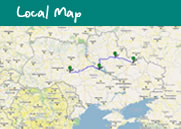
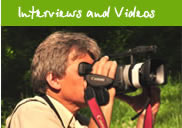
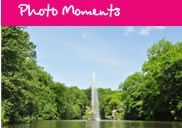
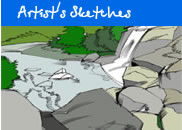
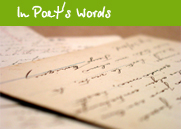






 Up to page
Up to page Print version
Print version